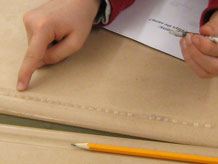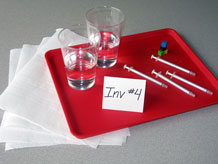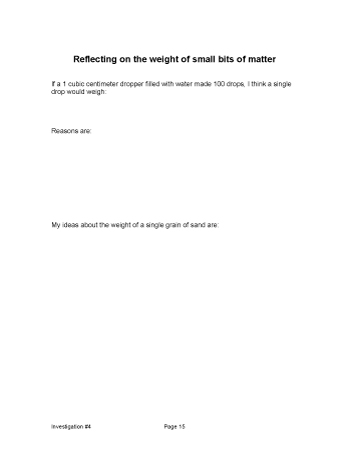What does a drop of water weigh?
Plan Investigation 4

How would we measure the weight of a single drop of water? When we put a drop of water on our classroom scale, it doesn't register any weight at all.
In this session students use a small dropper and a basic understanding of fractions to figure out the weight of a single drop of water. Why is this important? This starts a sequence of investigations in which students extend their understanding of what it means for an object to have weight. They progress from experience with objects that have clearly perceptible weight to objects for which weight is barely perceptible, such as a single drop of water. Eventually they consider particles too small to see, whose weight becomes apparent only when billions of them are present.
By the end of this investigation students will understand that when a sample of material is too small to weigh on their scales, they can use their knowledge of unit weight and volume to calculate the weight. They will also deepen their understanding that even the tiniest objects, such a single grain of sand, have weight.
Learning Goals
- Understand that very small things have weight
| Sequence of experiences | ||
|---|---|---|
| 1. Ask the question | All Class | 5 Mins |
| 2. Develop a strategy | All Class | 10 Mins |
| 3. Explore | Individual | 15 Mins |
| 4. Share the results | All Class | 5 Mins |
| 5. Make meaning | All Class | 10 Mins |
Materials and Preparation
For the class:
- Post the investigation question in a place where all students can see it.
- Make a class table titled, "What does a drop of water weigh?"; an example is found in Step 4.
- 1 digital scale

For each group:
- 2 12oz cups approximately1/2 full of water
- 4 1cc droppers (1cc small syringe)
- 4 centimeter cubes
- 4 paper towels





